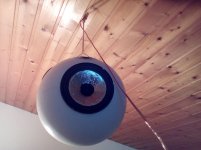Hello,
just another stupid question. Sorry🙂
Planning to put one of these chassis in a ripol sub.
LaVoce SAN/SAF 214.50
Is there a chance for them to work? Has somebody allready tried?
Thanks for your answers!
Regards,
Rene
just another stupid question. Sorry🙂
Planning to put one of these chassis in a ripol sub.
LaVoce SAN/SAF 214.50
Is there a chance for them to work? Has somebody allready tried?
Thanks for your answers!
Regards,
Rene
Last edited:
You can use any woofer. But in a ripole woofer those drivers are best with:
- more stiff suspension (because there is no enclosure limiting excursion)
- low fs (30 Hertz or lower)
- high Qts has advantages in open baffle use (0.7 or higher)
In my eyes the cheap drivers with long travel and high Qts can be of good use. Drivers with big magnets would have to be corrected by some means like inserting a big coil with thin wire in series. But 21 inch drivers with too small magnets for bass reflex or closed box use are hard to find!
A decent driver for small money is this one from italy (seen for 260€):
LSN21/8
- more stiff suspension (because there is no enclosure limiting excursion)
- low fs (30 Hertz or lower)
- high Qts has advantages in open baffle use (0.7 or higher)
In my eyes the cheap drivers with long travel and high Qts can be of good use. Drivers with big magnets would have to be corrected by some means like inserting a big coil with thin wire in series. But 21 inch drivers with too small magnets for bass reflex or closed box use are hard to find!
A decent driver for small money is this one from italy (seen for 260€):
LSN21/8
Attachments
In an open baffle construction a bass driver with high Q means more efficiency. Big magnets are counter productive in dipole. I discussed this here for a bass reflex design:
Just wanted to show off my new 18in build
With a higher Q the driver efficiency goes up at fs in an open baffle.
Just wanted to show off my new 18in build
With a higher Q the driver efficiency goes up at fs in an open baffle.
Hi, thanks for your reply and the link.
I already have two 18in ripole subwoofer from the Bastanis Mandala Atlas and like the sound/output.
So if the 21in can give me a bit more at the lower end(not louder) it’ll be nice.
Will have a look at the LSN21/8. But 260€ is almost the same as for the SAF214.50(fs30hz) 🤔
I already have two 18in ripole subwoofer from the Bastanis Mandala Atlas and like the sound/output.
So if the 21in can give me a bit more at the lower end(not louder) it’ll be nice.
Will have a look at the LSN21/8. But 260€ is almost the same as for the SAF214.50(fs30hz) 🤔
That's a bad idea. I posted about this before somewhere around here. TLDR; You would be better off just sticking the 21" driver (or your two existing 18" drivers) in a 24" tall planar baffle and EQing it/them.
Disclaimer: I am not a fan of the Ripole. But read on to understand why:
The ripole configuration puts the driver in a narrow slot. That slot has a very strong resonance because it is much deeper than it is wide. The depth of the slot sets the frequency of this resonance (it's a quarter wave, closed-pipe resonance) and you can calculate it via:
f=0.25*c/D
The depth, D, must be at least as deep as the driver is wide, plus a couple of inches. Also, there is an effect like with a port, where the "effective length" is actually longer by about half the width due to how air flows in slots and tubes.
For your 21" driver D will be something like 21" for the driver frame, 2" for some wood on either side and maybe another 2" contribution from the width of the ripole slot. This puts D at about 25" and using the forumula we get
F=138Hz
But because the Q of the resonance of a narrow slot like this is quite high, you cannot use the driver within about an octave of that because you need to strongly attenuate the resonance peak in the crossover network. Even an octave is cutting it close! So unless you want the system to have a strong drone at F, you need to crossover no higher than 0.5*F or less, which for this example would be at about 70Hz or lower. This also happens to remove much of the region where the ripole efficiency is high, and you are left with a low sensitivity system. Even if you use a high sensitivity driver you lose much of that and typically sensitivity is in the mid 80dB/W or lower and the dipole cancellation makes the overall LF output potential low. If you sit close to it and have a small apartment that cannot accommodate a larger dipole sub, that might be OK.
Oh, I almost forgot to mention that the 21" driver will be pumping away and this will cause a lot of vibration or movement.
IMHO about the only positive thing going for the Ripole is that it is small.
A more wideband Ripole sub can be achieved using multiples of more modestly sized (e.g. 12" class or less) drivers. Drivers are best used in opposed pairs, so that the vibration is largely canceled out, and with one driver's cone moving in the opposite direction as the other to reduce even order harmonic distortion. For example, the original Ripole used two 12" Peerless drivers and it's not bad (for a Ripole at least). Instead of the resonance occurring at F=138Hz it's more like F=200-250Hz so you can use the sub up to 100Hz or so, which is more reasonable and useful. By using multiple (e.g. four) 10" drivers you can further increase the upper end of the passband and the resulting system is still compact and more like a "cube" in shape, with the ripoles stacked together.
So, give it a think before falling for the "more is better" mantra and trying to build a Ripole with a single, large format woofer/subwoofer.
Disclaimer: I am not a fan of the Ripole. But read on to understand why:
The ripole configuration puts the driver in a narrow slot. That slot has a very strong resonance because it is much deeper than it is wide. The depth of the slot sets the frequency of this resonance (it's a quarter wave, closed-pipe resonance) and you can calculate it via:
f=0.25*c/D
The depth, D, must be at least as deep as the driver is wide, plus a couple of inches. Also, there is an effect like with a port, where the "effective length" is actually longer by about half the width due to how air flows in slots and tubes.
For your 21" driver D will be something like 21" for the driver frame, 2" for some wood on either side and maybe another 2" contribution from the width of the ripole slot. This puts D at about 25" and using the forumula we get
F=138Hz
But because the Q of the resonance of a narrow slot like this is quite high, you cannot use the driver within about an octave of that because you need to strongly attenuate the resonance peak in the crossover network. Even an octave is cutting it close! So unless you want the system to have a strong drone at F, you need to crossover no higher than 0.5*F or less, which for this example would be at about 70Hz or lower. This also happens to remove much of the region where the ripole efficiency is high, and you are left with a low sensitivity system. Even if you use a high sensitivity driver you lose much of that and typically sensitivity is in the mid 80dB/W or lower and the dipole cancellation makes the overall LF output potential low. If you sit close to it and have a small apartment that cannot accommodate a larger dipole sub, that might be OK.
Oh, I almost forgot to mention that the 21" driver will be pumping away and this will cause a lot of vibration or movement.
IMHO about the only positive thing going for the Ripole is that it is small.
A more wideband Ripole sub can be achieved using multiples of more modestly sized (e.g. 12" class or less) drivers. Drivers are best used in opposed pairs, so that the vibration is largely canceled out, and with one driver's cone moving in the opposite direction as the other to reduce even order harmonic distortion. For example, the original Ripole used two 12" Peerless drivers and it's not bad (for a Ripole at least). Instead of the resonance occurring at F=138Hz it's more like F=200-250Hz so you can use the sub up to 100Hz or so, which is more reasonable and useful. By using multiple (e.g. four) 10" drivers you can further increase the upper end of the passband and the resulting system is still compact and more like a "cube" in shape, with the ripoles stacked together.
So, give it a think before falling for the "more is better" mantra and trying to build a Ripole with a single, large format woofer/subwoofer.
I made a Ripole with an old 24 "FANE Colossus 24 bass. Here are the measurements.
Re = 7.344 Ohms
F (s) = 21.13 Hz
Qts = 0.7007
Qes = 0.7944
Qms = 5.944
Le = 2,723 mH
Mms = 456.6 g
Vas = 503.3 L
 [/url][/IMG]
[/url][/IMG]
The microphone is placed at the exit of the tunnel.
On the curves, you see the resonance of the tunnel. These are the curves as a function of the tunnel width and with 200 Hz / -48 dB cutoff. The tunnels are slightly conical, the big side towards the exit. The angles are sealed with polyurethane spray foam.
A forum where I show my speakers (in French)
Installation sap2212
Re = 7.344 Ohms
F (s) = 21.13 Hz
Qts = 0.7007
Qes = 0.7944
Qms = 5.944
Le = 2,723 mH
Mms = 456.6 g
Vas = 503.3 L

The microphone is placed at the exit of the tunnel.
On the curves, you see the resonance of the tunnel. These are the curves as a function of the tunnel width and with 200 Hz / -48 dB cutoff. The tunnels are slightly conical, the big side towards the exit. The angles are sealed with polyurethane spray foam.
A forum where I show my speakers (in French)
Installation sap2212
Nice setup😋
Are you pleased with the ripole, i guess yes. I can’t see any chains on them, so not much moving around 😉
Are you pleased with the ripole, i guess yes. I can’t see any chains on them, so not much moving around 😉
The speakers are upstairs. And the floor has a trampoline effect. On the orchestral covers you can feel the breath.
I made a Ripole with an old 24 "FANE Colossus 24 bass. Here are the measurements.
Re = 7.344 Ohms
F (s) = 21.13 Hz
Qts = 0.7007
Qes = 0.7944
Qms = 5.944
Le = 2,723 mH
Mms = 456.6 g
Vas = 503.3 L
The microphone is placed at the exit of the tunnel.
On the curves, you see the resonance of the tunnel. These are the curves as a function of the tunnel width and with 200 Hz / -48 dB cutoff. The tunnels are slightly conical, the big side towards the exit. The angles are sealed with polyurethane spray foam.
A forum where I show my speakers (in French)
Installation sap2212
Wow, that driver has great T.S. parameters for a dipole/Ripole subwoofer!
I am wondering about the "tunnel" shape inside the Ripole - you mention that it is "conical" but I think you mean shaped like a wedge. Can you describe this in more detail?
Also, how deep is the slot from the opening, and how wide is the opening. The taper may be suppressing the resonance, and that would be very interesting.
What do you think is the peak at 40-50Hz and the dip around 70-80Hz? A room mode?
Since this is a nearfield you do not show the front+back dipole cancellation. Have you estimated that? It is possible to calculate this for low frequency if you take a nearfield measurement with phase and add it to itself with delay D=c/L where L is the front to back pathlength and the "rear" data with reversed polarity. You need to be able to add the complex vector (amplitude and phase together) to do it.
As Charlie Laub stated - yes you need some attenuation of the frequency response for a Ripol - to do it only with a passive crossover needs a lot of care and is wasting efficiency.
If your sound source is a smartfone you can use the app "ExtraEQ" (31 band EQ) for example to make your loudspeaker linear. With "Spectroid" you can roughly measure the frequency response if you have file with pink or white noise playing from another source.
If your sound source is a smartfone you can use the app "ExtraEQ" (31 band EQ) for example to make your loudspeaker linear. With "Spectroid" you can roughly measure the frequency response if you have file with pink or white noise playing from another source.
I have two XTZ Amp 1 DSP with XTZ Room Analyzer Pro II with the 18” Ripole.
One or two IMG Stageline STA-2200DSP are in the pipeline��
No Passiv crossover
One or two IMG Stageline STA-2200DSP are in the pipeline��
No Passiv crossover
Hi,
regarding the specs of a woofer for a ripole concept I´d like to disagree slightly 😉
Especially with large sized drivers(>=15") a low Fs is counter productive.
A unique mark of a ripole is that the Fs drops by up to 15Hz(!), typically 5-10Hz.
Putting a large low-Fs driver into a ripole casing and the resulting Fb will be far below 20Hz ... thereby generating more problems tha solving some.
I´d rather suggest drivers with Fs between 30-35Hz.
With large drivers the optimum Qts is not higher than say 0.5.
Sonically a higher Qt driver will sound softer/muddied.
I find the optimum typically between 0.35 and 0.4.
There are loads of PA-drivers in the 15" and 18" class that fit this bill.
Regarding supsension character, I wouldn´t choose a stiff one, but rather a medium-to-soft one with a due degree of compression towards the excursion limits.
As CharlieLaub already mentioned will the bandwidth of such a large driver ripole be seriously restricted, due to the low chamber resonance frequency.
It´s not without reason, that the original ripoles all come with a passive notch filter, that´s intended to iron out the resonance peak.
Still though almost all ripoles are best crossed over below 100Hz.
jauu
Calvin
regarding the specs of a woofer for a ripole concept I´d like to disagree slightly 😉
Especially with large sized drivers(>=15") a low Fs is counter productive.
A unique mark of a ripole is that the Fs drops by up to 15Hz(!), typically 5-10Hz.
Putting a large low-Fs driver into a ripole casing and the resulting Fb will be far below 20Hz ... thereby generating more problems tha solving some.
I´d rather suggest drivers with Fs between 30-35Hz.
With large drivers the optimum Qts is not higher than say 0.5.
Sonically a higher Qt driver will sound softer/muddied.
I find the optimum typically between 0.35 and 0.4.
There are loads of PA-drivers in the 15" and 18" class that fit this bill.
Regarding supsension character, I wouldn´t choose a stiff one, but rather a medium-to-soft one with a due degree of compression towards the excursion limits.
As CharlieLaub already mentioned will the bandwidth of such a large driver ripole be seriously restricted, due to the low chamber resonance frequency.
It´s not without reason, that the original ripoles all come with a passive notch filter, that´s intended to iron out the resonance peak.
Still though almost all ripoles are best crossed over below 100Hz.
jauu
Calvin
I am wondering about the "tunnel" shape inside the Ripole - you mention that it is "conical" but I think you mean shaped like a wedge. Can you describe this in more detail?
The plan of the Ripole with the dimensions in centimeters.
An externally hosted image should be here but it was not working when we last tested it.
What do you think is the peak at 40-50Hz and the dip around 70-80Hz? A room mode?
I first built a larger prototype. I then looked for the best curve with 1cm plates in the tunnels.
An externally hosted image should be here but it was not working when we last tested it.
This corresponds to the different curves. The resonances are modified by the width of the tunnels.
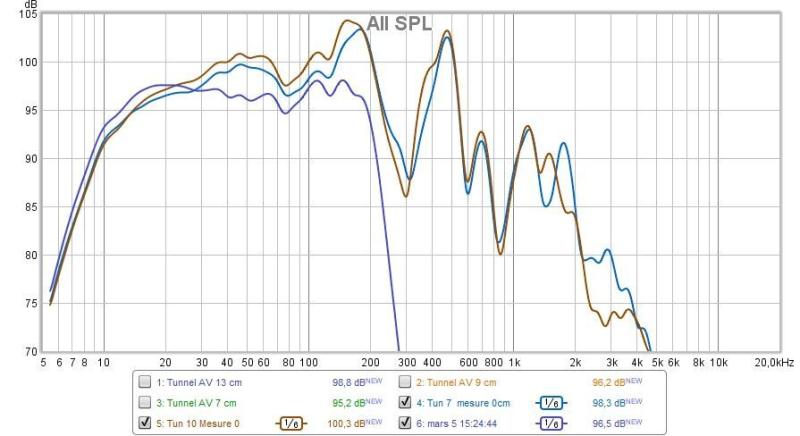
The cut at 200 Hz is made with an active filter. MiniDsp SHD studio. 48 dB / octave
Since this is a nearfield you do not show the front+back dipole cancellation. Have you estimated that? It is possible to calculate this for low frequency if you take a nearfield measurement with phase and add it to itself with delay D=c/L where L is the front to back pathlength and the "rear" data with reversed polarity. You need to be able to add the complex vector (amplitude and phase together) to do it.
The Ripole is very directive. On the sides, there is no bass sound. I don't know if the front output is cylindrical or spherical wave. But I think it's cylindrical or conical. If the Ripole is 1.2m from the back wall, the back wave reflects off the wall and returns to a spherical wave with a minimum delay of 3m. To measure it is not good, but to my ear the rear sound is heard as an echo. Maybe it's my brain filtering.
In another room, I use a JBL 4350. The Ripole is faster, the bass drops lower in frequency, and the harmonics of the instruments are more pronounced.
The Ripole is very directive. On the sides, there is no bass sound. I don't know if the front output is cylindrical or spherical wave. But I think it's cylindrical or conical. If the Ripole is 1.2m from the back wall, the back wave reflects off the wall and returns to a spherical wave with a minimum delay of 3m. To measure it is not good, but to my ear the rear sound is heard as an echo. Maybe it's my brain filtering.
Thanks for posting the diagram/drawing of the design. Now I understand how you used the foam to shape the back wall of the tunnel. This is probably why the reflection and resonance are not so strong.
The ripole has both front and rear output and they are of opposite phase or polarity. This is the reason that it is "directive" (your words above) - the two outputs should almost completely cancel 90 degrees off axis (to the sides).
You measured the response at the front opening, but that is just one of the outputs from the ripole. What about the other one? If you listen more than 0.5-1m away from the ripole you will also be hearing the rear output. To model the sound pressure correctly, you need to add the front and rear output to know what the far-field response is, because you are getting both of them and these interact and partially cancel at low frequencies even when you are directly in front of the ripole. When your listening position is very close to the front opening you are mostly in the near field and then your measurement is more like what you will hear because closest source dominates the overall sound.
When you are farther away from the ripole, the front and rear output combine and this results in a "down tilt" of the response at 6dB/oct at low frequency. Also, the interaction of the front and rear cause an additional peak to form, called the dipole peak. Your nearfield measurement will not show these features of the frequency response.
I am happy if you like the sound, but your measurement is not accurately showing the frequency response of the ripole when you are not very close to it.
Last edited:
The measurements are made without correction and without filtering.
Front tunnel measurement at 0 cm.
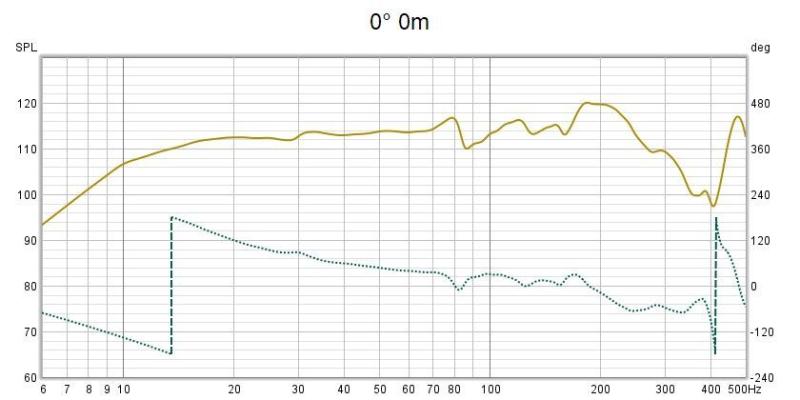
Rear tunnel measurement at 0 cm.
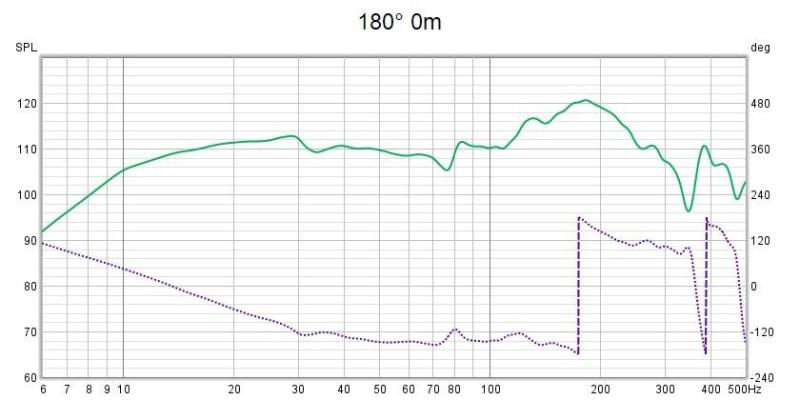
Front-to-back comparison and center measurement. (90°)
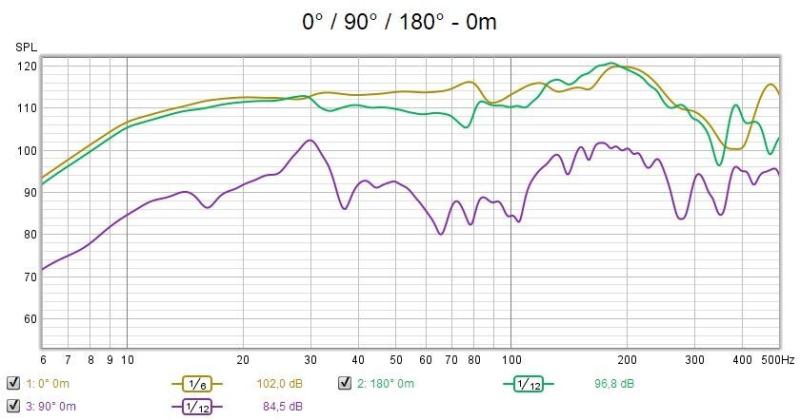
Distortion at the exit of the front tunnel.
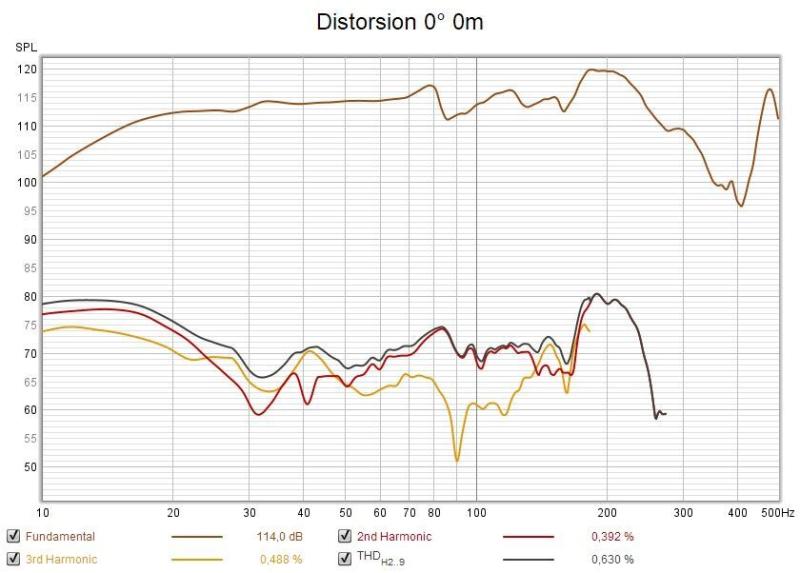
Measures for 0.5 m / 1 m / 2 m / 3 m. We have the slope of 6 dB/oct.
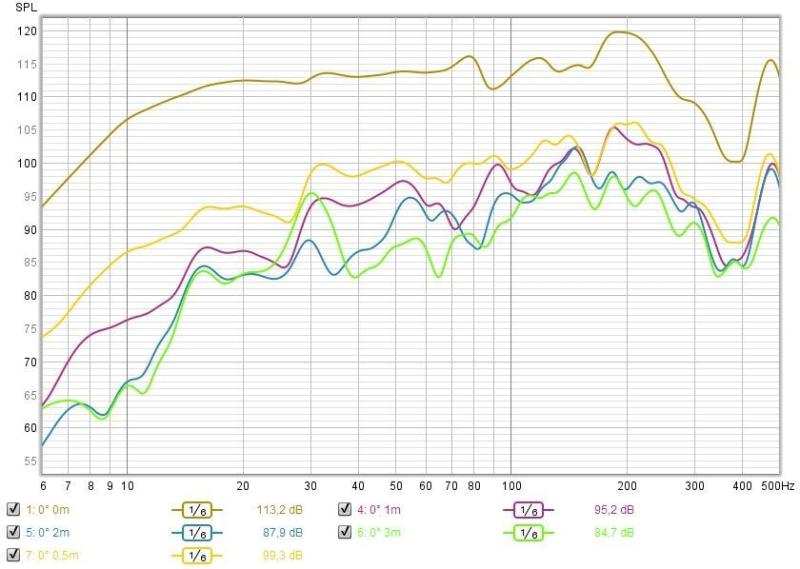
Measurement in the listening area. 2/4 m from the subwoofer
The rear stone wall is 4.3m from the enclosure. It changes the curve to 4 m.
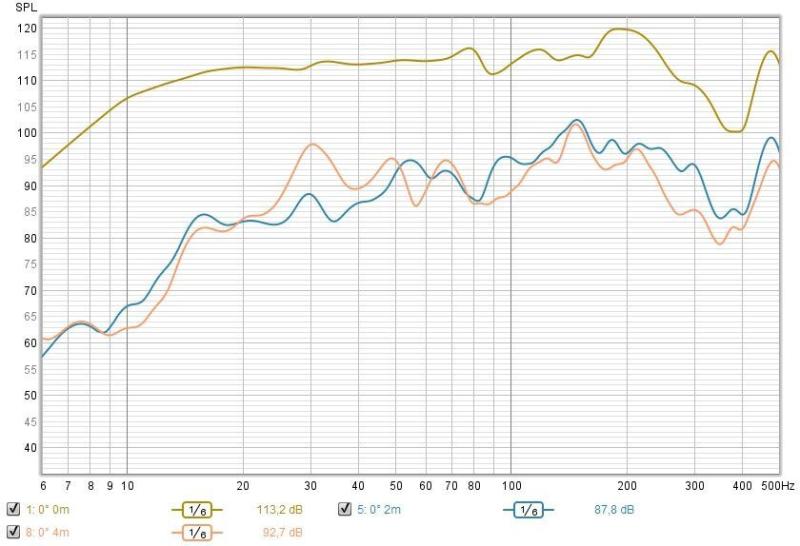
Front tunnel measurement at 0 cm.

Rear tunnel measurement at 0 cm.

Front-to-back comparison and center measurement. (90°)

Distortion at the exit of the front tunnel.

Measures for 0.5 m / 1 m / 2 m / 3 m. We have the slope of 6 dB/oct.

Measurement in the listening area. 2/4 m from the subwoofer
The rear stone wall is 4.3m from the enclosure. It changes the curve to 4 m.

Dipole Kugelbox - spherical box - 70ies reminiscence
Even more extreme than dipoles or Ripoles are loudspeakers without any woodwork - just tied up with ropes.
I never had the chance to listen to a system like this. But I guess it should be - sonically - a mixture of low distortion (enclosures made out of wood have lots of resonances as long as they are not built like tanks or with concrete) - low efficiency and and some unususal omnipolar pattern.
The sexiness of dipoles or open baffle systems for me would be the possibility of:
- Making a bad room with bass resonances sound better if the dipole can be positioned to your advantage
- easier woodwork and therefore less heavy built
The only thing I have built is a dual monopole in bass reflex and some added indirect firing tweeters, i.e. two fullrange drivers with their magnets facing each other.
The sonic character is positive - even listening to one box alone gives you the illusion of having a stereo box as the sound fills the room - maybe similar like the ancient Bose 901 system with indirect reflecting sound.
This is not for listeners who search the holy grail of sonic correctness but just want to have some fun not being forced to sit exactly in the stereo triangle.
Even more extreme than dipoles or Ripoles are loudspeakers without any woodwork - just tied up with ropes.
I never had the chance to listen to a system like this. But I guess it should be - sonically - a mixture of low distortion (enclosures made out of wood have lots of resonances as long as they are not built like tanks or with concrete) - low efficiency and and some unususal omnipolar pattern.
The sexiness of dipoles or open baffle systems for me would be the possibility of:
- Making a bad room with bass resonances sound better if the dipole can be positioned to your advantage
- easier woodwork and therefore less heavy built
The only thing I have built is a dual monopole in bass reflex and some added indirect firing tweeters, i.e. two fullrange drivers with their magnets facing each other.
The sonic character is positive - even listening to one box alone gives you the illusion of having a stereo box as the sound fills the room - maybe similar like the ancient Bose 901 system with indirect reflecting sound.
This is not for listeners who search the holy grail of sonic correctness but just want to have some fun not being forced to sit exactly in the stereo triangle.
Attachments
Sorry, but what has this do do with my question??
You should start your own thread to discuss this.
Thanks!
You should start your own thread to discuss this.
Thanks!
Hello Kallbo,
you have an 18 inch Ripole - how does it sound in comparison to other enclosure types (closed box or bass reflex)?
you have an 18 inch Ripole - how does it sound in comparison to other enclosure types (closed box or bass reflex)?
As the problem of the the slot resonance gets more and more pronounced along with bigger an bigger drivers: Can this resonance be "spread" into a broader frequency band by varying the slot geometry, e.g. by varying it's length and making it's walls less parallel? The picture shows some variants on a double ripole in antiparallel push-pull W-configuration. We are not talking of aesthetics, here ...
Attachments
Last edited:
Hello Kallbo,
you have an 18 inch Ripole - how does it sound in comparison to other enclosure types (closed box or bass reflex)?
I prefer it before the others. Bass is fast and clean, their when it is needed but disappears immediately. I don't like boomy bass. Prefer fast clean bass. not tried every design yet.
I have two magnat quantum 932a too, but don't realy like them. Planning to put the driver in double h-frame or stacked ripole. Two each side.
Plan B is to order one LSN21/8 from Germany and try it in ripole and H-frame.
- Home
- Loudspeakers
- Subwoofers
- 21“ in a Ripole subwoofer
